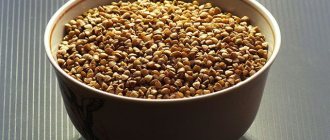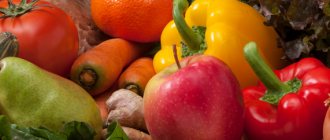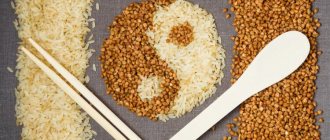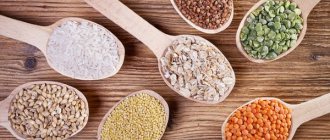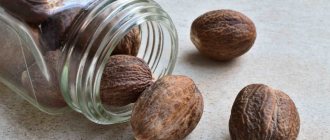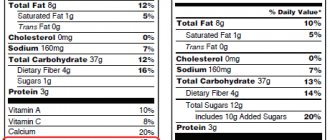An important part of any person’s diet are foods containing carbohydrates. Not only fats and proteins, but also carbohydrates take an active part in the metabolic processes occurring in the body. If a person feeds his body with proteins, fats and carbohydrates in the right quantities and in a balanced manner, then he can forget about serious metabolic disorders once and for all!
Carbohydrates are the main source of energy! They take part in the breakdown of fats and the structure of membranes at the cellular level, stimulate brain function, promote the synthesis of nucleic acids and amino acids, help the body cleanse itself of toxins and waste, protect it from many types of bacteria and viruses, and strengthen the immune system.
But not all foods containing carbohydrates are beneficial for our body. What plant foods contain carbohydrates that are beneficial for the human body? What types of carbohydrates exist and how do they differ from each other? Today we will try to find answers to these and many other questions regarding carbohydrates!
What are carbohydrates?
Carbohydrates are organic substances that are the main source of energy for your body. It is one of the three macronutrients you need to survive. The other two are proteins and fats .
Types of carbohydrates:
- Monosaccharides are the simplest carbohydrates that do not break down into even simpler ones. For example, glucose, fructose.
- Oligosaccharides are more complex compounds, built from several (up to 10) monosaccharide residues. For example, beet raffinose.
- Disaccharides are complex compounds built from 2 monosaccharide residues. For example, beet or cane sugar, lactose (milk sugar).
- Polysaccharides are complex compounds formed from a large number of glucose residues. They are divided into digestible (starch) and non-digestible (fiber). Fiber, due to its properties, has a beneficial effect on the entire body as a whole. Helps prevent many diseases, including cancer.
Calorie content of baked and stewed vegetables
Many vegetables are cooked before eating. Exposure to heat affects the calorie content of the product. For boiled vegetables, the calorie content changes slightly: for some it increases, for some it even decreases. You can compare the number of calories (per 100 grams of product) of boiled vegetables with the previous table.
- Boiled eggplant – 33-35
- sweet potato – 76
- broccoli – 35
- rutabaga – 30
- Brussels sprouts – 36
- zucchini – 20
- kale – 44
- white cabbage – 24
- cauliflower – 23
- jacket potatoes - 80-87
- kohlrabi – 30
- watercress – 24
- corn – 95
- onions – 40-45
- carrots – 33
- squash – 20
- sweet pepper – 25-30
- beets – 50
- asparagus – 23
- pumpkin – 16-22
- zucchini – 15
- spinach – 24
- sorrel – 20
During cooking, the beneficial qualities of the product decrease, but not so much as to abandon this method of preparation.
For baked vegetables, the calorie content per 100 grams of product also changes little if oil or fat is not added during the baking process. For baking, foil and a special sleeve are used. Nutrients are preserved better.
The calorie content of stewed vegetables depends on the method of preparing the dish and the amount of oil used. Vegetables tend to absorb oil, which significantly increases the calorie content of stewed vegetables. The number of calories in stewed zucchini will increase to 70-90, white cabbage - up to 50, potatoes - up to 190.
Functions of carbohydrates in the human body
- The role of carbohydrates is great. Once in the gastrointestinal tract, they are broken down into glucose, which in turn enters the cells and is used by the body as a source of energy. When they are insufficient to produce energy, proteins and fats break down, which leads to the accumulation of toxic ketones in the blood.
- They are able to accumulate in the liver, skeletal muscles, and other tissues in the form of glycogen.
- They take part in the synthesis of many substances necessary for the normal functioning of your body. For example, complex proteins, components of the immune system, etc.
- Regulates the metabolism of proteins and fats.
- Necessary for the normal functioning of the heart, liver, muscles and central nervous system.
Artichokes
Artichokes require special preparation; their most valuable part is the core, which is located under a layer of dry leaves. This vegetable has a unique taste and contains many nutrients.
Artichokes are rich in magnesium, are good for maintaining heart health and are known as prebiotics, which help support healthy digestion.3
What foods contain carbohydrates
Most foods are carbohydrates. They are not found in products of animal origin (meat, fish and seafood, eggs, etc.). The exception is dairy products that contain the milk sugar lactose.
Sources:
- Fruits.
- Vegetables, greens.
- Cereals, different types of flour.
- Nuts and seeds.
- Legumes (beans, peas, lentils, soybeans).
- Bread, pastries, cakes, pastries, etc.
- Pasta, noodles.
- Sugar, starch, honey.
- Carbonated drinks with sugar, compote, juices, tea and coffee with sugar.
- Alcohol.
- Dairy products, etc.
Broccoli
Broccoli is a popular vegetable from the cruciferous family. The product is easy to prepare at home, but it is often offered in restaurants as part of various dishes.
Broccoli is very low in carbohydrates - about 0.4 g per 100 g
product. This is an excellent ingredient for many dishes: broccoli can be added to an omelette when preparing breakfast, cooked as a side dish for lunch or dinner. All cruciferous vegetables, which include broccoli, are rich in antioxidants. Apart from this, broccoli can also support bone health due to its calcium content. This plant also contains vitamin C, which means it will support the immune system.2
Grocery list
Simple carbohydrates
Complex carbohydrates
Brussels sprouts
This is another vegetable from the cruciferous family, which it is advisable to include more often in the menu.
Shredded Brussels sprouts and added to the salad will make it more nutritious. If you cook it in the oven at high temperature, it acquires a sweetish taste. If you're following a keto diet, add some bacon to your Brussels sprouts for a great side dish!
Brussels sprouts contain alpha lipoic acid and have many potential health benefits.5
Daily carbohydrate needs
The daily intake will be different for each person.
On the Internet, some sites claim that the carbohydrate norm is 3–5 g per 1 kg of weight. In reality, everything is more complicated. The norm must be calculated for each person individually .
The need depends on gender, age, weight, activity level , etc. Also, your current goals are of great importance. For example, when losing weight and gaining muscle mass, you need completely different amounts of carbohydrates per day.
As an example, calculations were made for a 30-year-old man and woman of average height and low activity. See table below.
In the case of weight gain, average activity was taken (3 workouts per week).
Based on your gender, weight, and weight goals, you can determine your carbohydrate needs. Of course, the figure is approximate, but the error will not be very large.
| 50 -55 kg | 55-60 kg | 60-65 kg | 65-70 kg | 75-80 kg | 80-85 kg | |
| Men | ||||||
| Weight loss | 140 | 145 | 150 | 155 | 160 | 165 |
| Weight maintenance | 160 | 165 | 170 | 175 | 180 | 185 |
| Muscle gain | 270 | 280 | 290 | 300 | 315 | 325 |
| Women | ||||||
| Weight loss | 110 | 115 | 120 | 125 | 135 | 140 |
| Weight maintenance | 130 | 137 | 145 | 150 | 160 | 165 |
| Muscle gain | 228 | 240 | 245 | 255 | 270 | 280 |
When gaining muscle mass, the body needs a lot of energy. In this case, it is recommended to focus on foods high in carbohydrates. Of course, not forgetting about proteins and fats.
Lack of carbohydrates
A deficiency can cause weakness, fatigue, irritability, and apathy. In addition, muscle tissue and fat reserves, as well as proteins and fats supplied with food, will begin to be used as a source of energy.
Excess carbohydrates
Excessive amounts of them lead to a set of extra pounds .
Abuse of simple carbohydrates can lead to diabetes, arterial hypertension, insulin resistance, cardiovascular diseases and cancer.
Complex carbohydrates , on the contrary, can prevent these and other diseases . Fiber plays a big role here.
When the need increases
Since carbohydrates are the main source of energy, the need for them increases with increased mental and physical activity. If you decide to play sports, gain muscle mass, or your new job involves heavy physical activity, increase the amount of carbohydrate-containing foods.
Do fruits make you fat?
Forget this established myth about the incredible calorie content of fruits and the “up to 16” rule. It is considered normal to consume about 60 grams PURE fructose (not carbohydrates found in fruits, but fructose) daily.
BUT : In order to eat 60 grams of pure fructose from fresh fruits, you need to eat kilograms of them. Fruits contain a lot of water and fiber, and in addition, they create a feeling of fullness very quickly.
Eat, eat fruit! It is an excellent source of vitamins, fiber and minerals and is mostly low in calories.
People often ask: are fruits carbohydrates or fiber? The answer is simple: it’s both. And, by the way, fiber is also carbohydrates, just not broken down and poorly digestible.
Fructose, clear about the complex
A possible way to eat excess fructose is to consume sugary drinks, regular sugar (50% fructose), fructose syrups, sweets and sweeteners.
By the way, after a workout, the most beneficial and nutritious thing for your muscles will be a cocktail of whey protein and banana or natural grape juice. You will nourish the body with fructose, which will fill the glycogen depots depleted during the workout and feed the muscles with proteins.
Most importantly, people who maintain a calorie deficit and exercise regularly should not be afraid of fructose.
Banana: friend or foe?
You will gain weight even on buckwheat if you eat kilos of it. People get fat from a general excess of calories, not from fruits. Therefore, fruits and any other foods can be eaten at any time of the day, as long as you do not go beyond your caloric intake limits.
Any restrictions on the timing of carbohydrate intake are nothing more than an attempt to force a person to eat less during the day if he does not count calories.
No single food or nutrient is the sole cause of excess weight. People gain weight when they regularly eat more calories than they need.
RESULT : Large amounts of PURE glucose, which cannot be obtained from fruits, are harmful.
Bell peppers
Chili peppers were listed above due to their capsaicin content. Bell peppers are sweeter in taste and contain only 2.5 g of carbohydrates per 100 g.
This is an excellent ingredient for salads and sandwiches.
Peppers come in green, yellow, red and orange, but the green variety contains the least amount of carbohydrates. Bell peppers are a good source of fiber, so adding them to a variety of dishes can increase satiety and bulk up your meal.
Try making stuffed peppers with minced meat and bulgur according to our recipe:
Recipes
Stuffed peppers with minced meat and bulgur | A dish for a good mood
Sometimes carbohydrates can do a good job. We offer you a delicious and quick recipe that will help provide your body with vitamins and improve your mood.
2020-10-14 18:00:07 • Lauren Dawes
Diet rich in fiber
A diet rich in fiber is very beneficial for health. But it is important to switch to a new nutrition program gradually, adding 5 g of the substance per day. A faster transition may cause bloating, cramping, and diarrhea. Also, nutritionists from the University of Michigan advise slightly reducing the amount of caffeine-containing drinks while taking fiber. Caffeine acts on the body as a diuretic, and fluid loss due to the consumption of large amounts of fiber is fraught with constipation.
Dietary fiber will help replenish your diet; you don’t have to immediately resort to taking dietary supplements. To do this, you should pay attention to fruits and berries. Ideally, they should be consumed in small portions throughout the day. The next recommendation from nutritionists is to start the day with oatmeal or bran with berries. As for protein foods, in addition to meat, it is important to include plant proteins (beans, beans, lentils) in your diet, which are also excellent sources of fiber. For a fiber-rich dinner, broccoli, collard greens, corn, whole grain pasta, and brown rice are ideal options.
Eggplant
Eggplant is the fruit of a herbaceous plant from the nightshade family. It has a dark purple color, but the color of the fruit may vary depending on the degree of ripeness or variety.
Eggplant contains a lot of potassium, which means it has a beneficial effect on the cardiovascular system. It's also high in fiber and water, making it a good low-carb dough substitute in lasagna or dishes that use Parmesan. This is a low-calorie and nutritious product that is included in the menu of many diets. Of course, diets require that eggplants be grilled or steamed, without oil.
Eggplant is a frequently used ingredient in Asian cuisine. Roasted eggplant is the main ingredient in baba ganoush sauce. And also a very tasty dish - vegan masala with eggplant.
Soluble fiber vs. insoluble fiber
Dietary fiber consists of non-starch polysaccharides such as cellulose, dextrins, inulin, lignin, chitin, pectins, beta-glucans, waxes and oligosaccharides.
There are two main types of fiber: soluble and insoluble.
Soluble fiber
Soluble fiber, as the name implies, dissolves in an aqueous environment, and when passing through the digestive tract, it can be fermented, after which it acquires a jelly-like consistency. It slows down the digestion process, resulting in a feeling of fullness that lasts longer. Thanks to this ability, it helps control appetite, and therefore weight.
Benefits of Soluble Fiber:
- reduces the level of “bad” cholesterol;
- regulates blood sugar concentration, which is important for diabetics and people with metabolic syndrome.
Products containing soluble fiber: fruit pulp, beans, peas, carrots, oats, flaxseeds. All these products dissolve in the body to a gel-like texture.
Insoluble fiber
Benefits of Insoluble Fiber:
- promotes proper intestinal motility and prevents constipation;
- accelerates the removal of toxins from the body through the colon;
- maintains optimal acidity levels in the intestines.
Insoluble fiber retains its shape throughout all stages of digestion. Accelerates the passage of food through the gastrointestinal tract and its elimination, which prevents constipation. Examples of insoluble fiber are hemicellulose, cellulose and lignin.
Foods rich in insoluble fiber: vegetables and fruits (peels), beans, greens, nuts, seeds.
Many foods contain both soluble and insoluble fiber. But their proportions vary. Meanwhile, substances from both categories have a beneficial effect on the functioning of the body.
Legumes
Legumes contain the highest amount of fiber compared to other food groups. Legumes are also high in protein, making them a good meat alternative for vegetarians.
| Type of beans, 1 cup | grams of fiber |
| White beans | 11 |
| Red beans | 11 |
| Black beans | 15 |
| Edamame | 8 |
| Pinto beans | 15 |
| Green peas | 8,8 |
| Lentils | 15 |
| Chickpeas | 12,5 |



